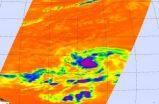(Press-News.org) PASADENA, Calif.—Researchers at the California Institute of Technology (Caltech) have devised a new technique—using a sheet of carbon just one atom thick—to visualize the structure of molecules. The technique, which was used to obtain the first direct images of how water coats surfaces at room temperature, can also be used to image a potentially unlimited number of other molecules, including antibodies and other biomolecules.
A paper describing the method and the studies of water layers appears in the September 3 issue of the journal Science.
"Almost all surfaces have a coating of water on them," says James Heath, the Elizabeth W. Gilloon Professor and professor of chemistry at Caltech, "and that water dominates interfacial properties"—properties that affect the wear and tear on that surface. While surface coatings of water are ubiquitous, they are also very tough to study, because the water molecules are "in constant flux, and don't sit still long enough to allow measurements," he says.
Quite by accident, Heath and his colleagues developed a technique to pin down the moving molecules, under room-temperature conditions. "It was a happy accident—one that we were smart enough to recognize the significance of," he says. "We were studying graphene on an atomically flat surface of mica and found some nanoscale island-shaped structures trapped between the graphene and the mica that we didn't expect to see."
Graphene, which is composed of a one-atom-thick layer of carbon atoms in a honeycomb-like lattice (like chicken wire, but on an atomic scale), should be completely flat when layered onto an atomically flat surface. Heath and his colleagues—former Caltech graduate student Ke Xu, now at Harvard University, and graduate student Peigen Cao—thought the anomalies might be water, captured and trapped under the graphene; water molecules, after all, are everywhere.
To test the idea, the researchers conducted other experiments in which they deposited the graphene sheets at varying humidity levels. The odd structures became more prevalent at higher humidity, and disappeared under completely dry conditions, leading the researchers to conclude that they indeed were water molecules blanketed by the graphene. Heath and his colleagues realized that the graphene sheet was "atomically conformal"—it hugged the water molecules so tightly, almost like shrink wrap, that it revealed their detailed atomic structure when examined with atomic force microscopy. (Atomic force microscopes use a mechanical probe to essentially "feel" the surfaces of objects.)
"The technique is dead simple—it's kind of remarkable that it works," Heath says. The method, he explains, "is sort of like how people sputter carbon or gold onto biological cells so they can image them. The carbon or gold fixes the cells. Here, the graphene perfectly templates the weakly adsorbed water molecules on the surface and holds them in place, for up to a couple of months at least."
Using the technique, the researchers revealed new details about how water coats surfaces. They found that the first layer of water on mica is actually two water molecules thick, and has the structure of ice. Once that layer is fully formed, a second, two-molecule-thick layer of ice forms. On top of that, "you get droplets," Heath says. "It's truly amazing that the first two adsorbed layers of water form ice-like microscopic islands at room temperature," says Xu. "These fascinating structures are likely important in determining the surface properties of solids, including, for example, lubrication, adhesion, and corrosion."
The researchers have since successfully tested other molecules on other types of atomically flat surfaces—such flatness is necessary so the molecules don't nestle into imperfections in the surface, distorting their structure as measured through the graphene layer. "We have yet to find a system for which this doesn't work," says Heath. He and his colleagues are now working to improve the resolution of the technique so that it could be used to image the atomic structure of biomolecules like antibodies and other proteins. "We have previously observed individual atoms in graphene using the scanning tunneling microscope," says Cao. "Similar resolution should also be attainable for graphene-covered molecules."
"We could drape graphene over biological molecules—including molecules in at least partially aqueous environments, because you can have water present—and potentially get their 3-D structure," Heath says. It may even be possible to determine the structure of complicated molecules, like protein–protein complexes, "that are very difficult to crystallize," he says.
Whereas the data from one molecule might reveal the gross structure, data from 10 will reveal finer features—and computationally assembling the data from 1,000 identical molecules might reveal every atomic nook and cranny.
If you imagine that graphene draped over a molecule is sort of like a sheet thrown over a sleeping cat on your bed, Heath explains, having one image of the sheet-covered lump—in one orientation—"will tell you that it's a small animal, not a shoe. With 10 images, you can tell it's a cat and not a rabbit. With many more images, you'll know if it's a fluffy cat—although you won't ever see the tabby stripes."
###
The work in the paper, "Graphene Visualizes the First Water Adlayers on Mica at Ambient Conditions," was funded by the United States Department of Energy's Office of Basic Energy Sciences.
Caltech chemists develop simple technique to visualize atomic-scale structures
2010-09-04
ELSE PRESS RELEASES FROM THIS DATE:
LSUHSC pediatric weight expert provides obesity trinity answers
2010-09-04
New Orleans, LA – In a first person paper published in the August 27, 2010 issue of Childhood Obesity, Dr. Melinda Sothern, Director of Health Promotion and Professor of Public Health at LSU Health Sciences Center New Orleans, provides three ways to de-program the 1950s obesity trinity underlying the current obesity epidemic in the United States and protect future generations from its health consequences.
"The combination of prenatal tobacco use, infant formula, and frequent pregnancies—
i.e., the obesity trinity—synergistically created the first generation of nutritionally ...
UCSF unveils model for implantable artificial kidney to replace dialysis
2010-09-04
UCSF researchers today unveiled a prototype model of the first implantable artificial kidney, in a development that one day could eliminate the need for dialysis.
The device, which would include thousands of microscopic filters as well as a bioreactor to mimic the metabolic and water-balancing roles of a real kidney, is being developed in a collaborative effort by engineers, biologists and physicians nationwide, led by Shuvo Roy, PhD, in the UCSF Department of Bioengineering and Therapeutic Sciences.
The treatment has been proven to work for the sickest patients using ...
NASA catches heavy rainfall happening in Category 4 Earl as it approaches the US
2010-09-04
Hurricane Earl is still a powerful category four hurricane on the Saffir-Simpson Scale as it approaches the North Carolina coast today. NASA's Tropical Rainfall Measuring Mission (TRMM) satellite observed the high rates rain was falling within Earl, in some areas more than 2 inches per hour. Today, the Global Hawk unmanned aircraft is also flying into the eye of Hurricane Earl at altitudes of 60,000 feet to gather information about the storm.
Hurricane Earl became the most powerful hurricane of the 2010 Atlantic season early on September 2 when its sustained winds reached ...
Laser-based missile defense for helicopters being developed
2010-09-04
ANN ARBOR, Mich.---Protecting helicopters in combat from heat-seeking missiles is the goal of new laser technology created at the University of Michigan and Omni Sciences, Inc., which is a U-M spin-off company.
"Battlefield terrain in places like Afghanistan and Iraq can be so rough that our troops have often had to rely on helicopters, and they can be easy targets for enemies with shoulder-launched missiles," said Mohammed Islam, a professor in the Department of Electrical Engineering and Computer Science.
"Our lasers give off a signal that's like throwing sand in ...
Bermuda in warnings as the GOES-13 Satellite catches Fiona approaching
2010-09-04
Bermuda has warnings up as Tropical Storm Fiona approaches, and GOES-13 satellite imagery from today shows that Fiona, although packing a punch, is a much smaller system that her brother, the Category 4 Hurricane Earl.
A tropical storm warning is in effect for Bermuda today, Sept. 2, as tropical storm force winds are expected there by late Friday. Bermuda can expect between 1 to 3 inches of rainfall from Fiona.
When the Geostationary Operational Environmental Satellite called GOES-13 captured a visible image of Tropical Storm Fiona approaching Bermuda this afternoon ...
Cigarette smoke may contribute to lung inflammation through a new chemical pathway
2010-09-04
BIRMINGHAM, Ala. – Cigarette smoke shuts off a key enzyme in airways that regulates the body's response to inflammation, according to findings from the University of Alabama at Birmingham published online today at Science Express.
The UAB researchers say smoke inhibits the enzyme, called Leukotriene A4 Hydrolase (LTA4H), causing it to fail in its job of shutting down white blood cells following a successful response to inflammation.
The team says the research study identified a previously unknown substrate of LTA4H called proline-glycine-proline (PGP). In a normal ...
New model may simplify high-dose radiosurgery planning
2010-09-04
COLUMBUS, Ohio – There is yet no straightforward way to determine the optimal dose level and treatment schedules for high-dose radiation therapies such as stereotactic radiation therapy, used to treat brain and lung cancer, or for high-dose brachytherapy for prostate and other cancers.
Radiation oncologists at the Ohio State University Comprehensive Cancer Center-Arthur G. James Cancer Hospital and Richard J. Solove Research Institute (OSUCCC-James) may have solved the problem by developing a new mathematical model that encompasses all dose levels.
Typically, radiation ...
American Society for Biochemistry and Molecular Biology reacts to stem-cell ruling
2010-09-04
BETHESDA, Md., Sept. 2, 2010 – The American Society for Biochemistry and Molecular Biology expressed its disapproval and disappointment this week in response to the Aug. 23 ruling in the U.S. District Court for the District of Columbia that granted a preliminary injunction barring federal funding of embryonic stem-cell research.
In a statement, the society said the decision, which came in response to a lawsuit filed by two adult stem-cell researchers, effectively halts human embryonic stem-cell research in the United States and "represents a crossroads in American scientific ...
Report: Discovery networks hostage-taking a rare terror event
2010-09-04
COLLEGE PARK, Md. – A new report by terrorism researchers at the University of Maryland concludes that the deadly hostage-taking incident at the Discovery Communications headquarters in suburban Washington, D.C. meets the criteria of a terrorist act – a rare one for media organizations and the nation's capital region. Hostage-taking, though, is a familiar pattern in capital-region terror, the researchers add.
The report from the University of Maryland's START Center – the federally funded National Consortium for the Study of Terrorism and Responses to Terrorism – also ...
NASA sees Depression Nine become Gaston then back to a depression
2010-09-04
Tropical Depression Nine strengthened yesterday into Tropical Storm Gaston, but today it ran into dry and stable air and weakened back into a depression again.
When NASA's Aqua satellite flew over Gaston early this morning, Sept. 2 at 0423 UTC (12:23 a.m. EDT), the infrared image taken from the Atmospheric Infrared Sounder (AIRS) instrument showed that Tropical Depression Gaston seemed to have a compact circulation with some high, cold thunderstorm cloud tops around its center of circulation. Those clouds reached so high into the troposphere that they were colder than ...



